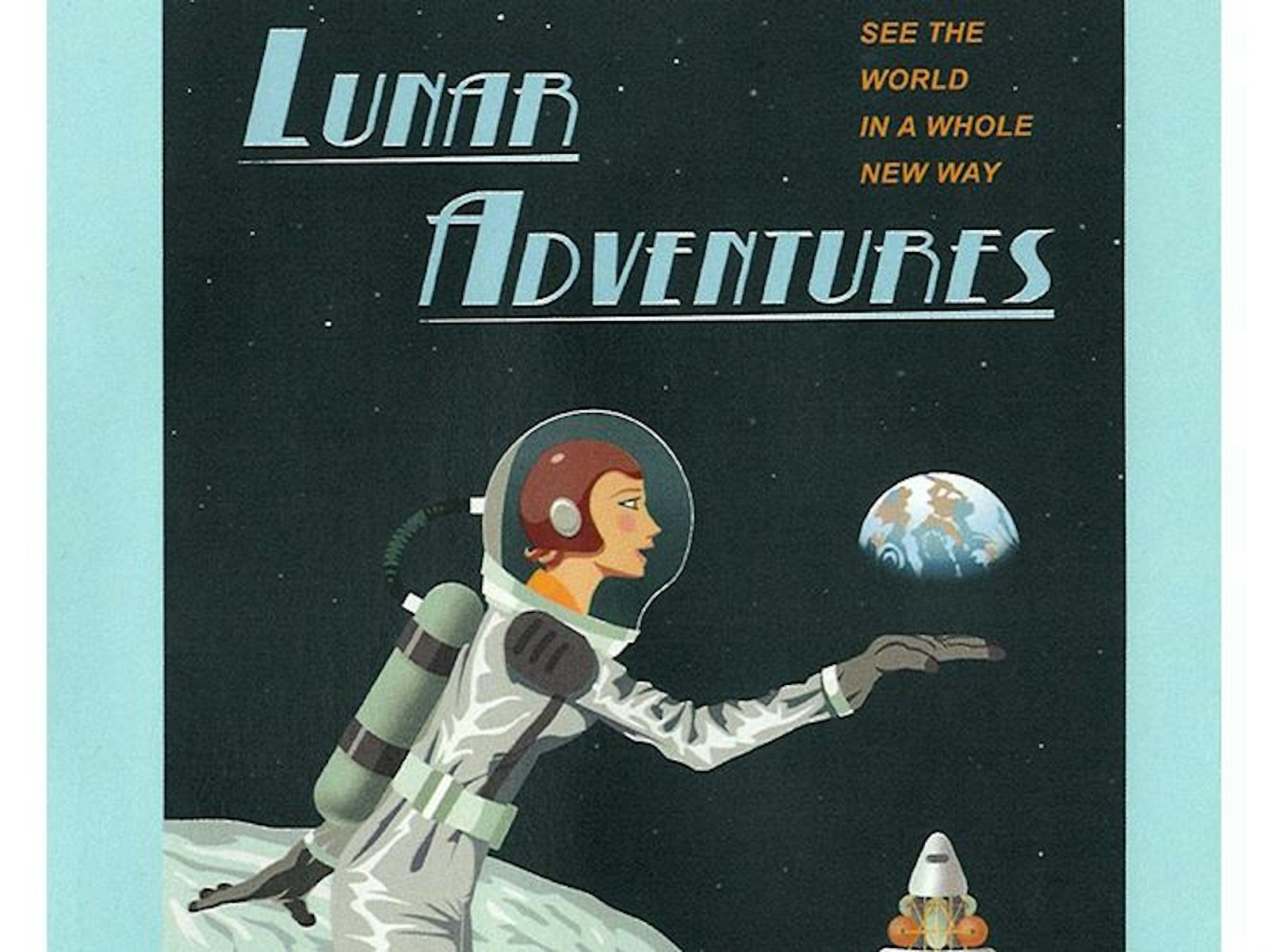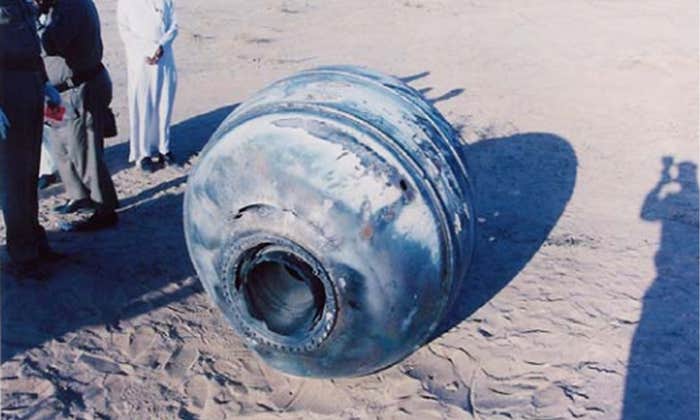Trudging through the mire of midtown Manhattan in the middle of a July heat wave makes you long for relief from your earthly trials—and at the corner of 8th Avenue and 37th Street last week, you could find one. Nautilus popped in to the Intergalactic Travel Bureau, a pop-up shop promoting moon-hopping, sun-surfing, and all forms of interplanetary tourism. The Bureau’s cheerful staff of astronomers, physicists, and mathematicians helped clients plan a variety of trips, some of which ran to the billions of dollars. We spoke to two “travel agents to the stars,” Olivia Koski and Jana Grcevich*. Below is an edited transcript of that conversation.
What sets you apart from a standard travel agency?
Koski: We are the only travel bureau that offers space vacations exclusively. I think a lot of people are getting a tired of the Earth and want a little break. We meet with a lot of different clients who have a lot of different needs, and ask them what they enjoy: relaxation, adventure, maybe a little romance…? And we tailor the experience to their particular tastes.
Where in the solar system could I go for a relaxed beach-style holiday?
Grcevich: It’s a bit difficult to find liquids on surfaces of terrestrial planets. But one option is Titan, a moon of Saturn, which has liquid methane lakes. You can float on them and go walking along the edge. It’s nice because Titan has a very thick atmosphere—so thick, in fact, that you have to wear a specially designed spacesuit to avoid being crushed to death by the pressure. But that dense atmosphere gives you a nice romantic haze. The thing is, it will take you upwards of six years to get there, based on probes we’ve sent.
If you’re interested in a warmer experience you might want to check out Mercury, the closest planet to the Sun. It gets quite hot on the Sun-facing side, so we like to recommend that people hike along the lip between the light and the dark side. The contrast produces these dramatic shadows. It’s great for black and white photography.
What if I’m feeling more adventurous?
Grcevich: We have lots of great options for hiking in the inner solar system, since that’s where you find planets with surface you can actually walk on. Mars is a prime location, with beautiful red rocks thanks to the iron oxide content. You can go low-gravity rock-climbing in Valles Marineris, a Martian gorge which is three times the depth of the Grand Canyon. I’m sorry, just it puts the Grand Canyon to shame, right? You might also want to check out Olympus Mons, which is the solar system’s largest volcano. It’s dormant, so you don’t have to worry about that. And it’s a lot of fun—you can cover a lot of ground when you’re hiking in low gravity. I highly recommend it.
Perhaps you’d enjoy our solar wind package. You rent a sailboat, unfurl the large, reflective solar sail, and catch the radiation pressure from the charged particles coming off the surface of the Sun. As you cruise around, you get beautiful views of the granulations and surfaces of the Sun; the convection cells look like boiling butter; it’s really beautiful. But I am required by law to tell you that we have a 50 percent fatality rate for solar sailors, due to the flares and prominences coming off the surface of the Sun which are quite large compared to Earth—you can get caught in those and burnt up pretty quickly. So it’s not for the faint of heart.
Tell me more about the outer solar system. I want to go somewhere exotic.
Grcevich: The Bureau has some great ski packages for Pluto. It used to be a proper planet but is now classified as a “dwarf planet” [an object in orbit around a star that is big enough to turn itself into a sphere, but too small to suck in or scatter other objects in its orbital zone]. But it’s the same old Pluto that you remember from your childhood. Due to the demotion we are offering ten percent off of all our ski trips. The low gravity means you can get a lot of height on jumps, although I wouldn’t exactly call the surface a good powder for skiing. It’s more like a mix of hard ice and rock, and it’s kind of charcoal grey in color. Still, it’s a lot of fun. And Pluto has a large moon called Charon, which is a beautiful sight in the sky. And once you’re done skiing you can always hang out in the chalets, which are great spot for a debate about Pluto’s status.

Can you book multi-stop trips—an “around the worlds” interplanetary tour?
Grcevich: We can put together any itinerary that you’re interested in—in fact, we can even send you beyond the solar system. You might want to visit Andromeda M31, which is the nearest spiral galaxy to our galaxy, the Milky Way. But it’s a one-way trip. We definitely don’t guarantee that you’re going to make it out there alive, and we certainly don’t promise that you’ll make it back. The distances are quite difficult for people to fathom.
Koski: Even our closest star [Proxima Centauri], which is 4.3 light-years away, would take tens of thousands of years to reach with current technologies.
Is there any chance of encountering an extraterrestrial culture?
Grcevich: Of course there’s a chance. But we’re probably going to be sending you to destinations that are quite nearby, within our own galaxy, where we would have detected radio signals from any intelligent civilizations. We’re really only able to listen to a small area, and that’s the same area we would go to. But you never know—I mean, space is extremely large. There are lots of stars and, as we’re discovering every week, there are lots of planets orbiting those stars, and we don’t know the full extent of what’s out there.
How much does this all cost?
Grcevich: Here at the Intergalactic Travel Bureau we take cash, check, credit, and bitcoin; we also do layaway. We’re willing to accept any form of currency that you might be willing to provide to us. As an example, if you want to go to Mars, that’s going to be $6 billion; for the International Space Station, the cost is $30 million, which is what some tourists have previously paid.
Koski: These are all based on our competitors’ prices. A lot of people ask, “Is this for real, can you really go to space?” And while some of the destinations beyond our solar system might be a little bit more challenging to get to, all of these packages are either within our grasp or have already been reached. Some [commercial] suborbital trips to visit the edge of space are supposed to launch later this year at cost of only $200,000 per flight. They will give you a beautiful view of the Earth.
What if I’m looking for night life?
Grcevich: Jupiter is the solar system’s premier party planet. It has all these beautiful colors, from the different chemical compositions of the different layers of atmosphere. The biggest party of them all, of course, is the great red spot, which most people are familiar with. It’s larger than Earth. You can go hang out there in the high winds and enjoy a crazy party! You might also want to take a submarine tour of the subsurface ocean of Europa [one of Jupiter’s moons], or visit Io, whose surface is covered in volcanoes.
Where would I find the most striking landscapes?
Grcevich: If you hang out on [Daphnis or Pan, two of] Saturn’s moons, you’ll get a view of the ripple effect they create in the planet’s rings as they pass by. You might also want to visit Saturn’s northern polar vortex, which is a hexagon right above the planet’s north pole. It sounds crazy but it’s true! The differential rotation between the layers of Saturn’s atmosphere creates a dip in the clouds in the shape of a hexagon, and reveals the different colors of the clouds underneath.
*Note: If you haven’t yet visited the Intergalactic Travel Bureau, we regret to inform you that that (space)ship has sailed. The Bureau was only open for a short time, but it lives on in our memories as a project that stimulated thoughts and dreams about what off-world tourism might be like. After the Bureau’s closure, Koski resumed her job as a multimedia journalist, and Grcevich returned to the American Museum of Natural History, where she’s an astronomer and postdoctoral fellow.




























